The P-18PL radar station is one of the latest designs of the PIT-Radwar company (part of the Polish Armament Group). In December last year, its qualification tests were finished with a positive result, paving the way for an order by the Polish military and the start of mass production. The new radar is unusual in one respect—as a VHF (Very high frequency) device, it operates using radio waves one to ten meters in length, which is unheard of in case of Western radars.
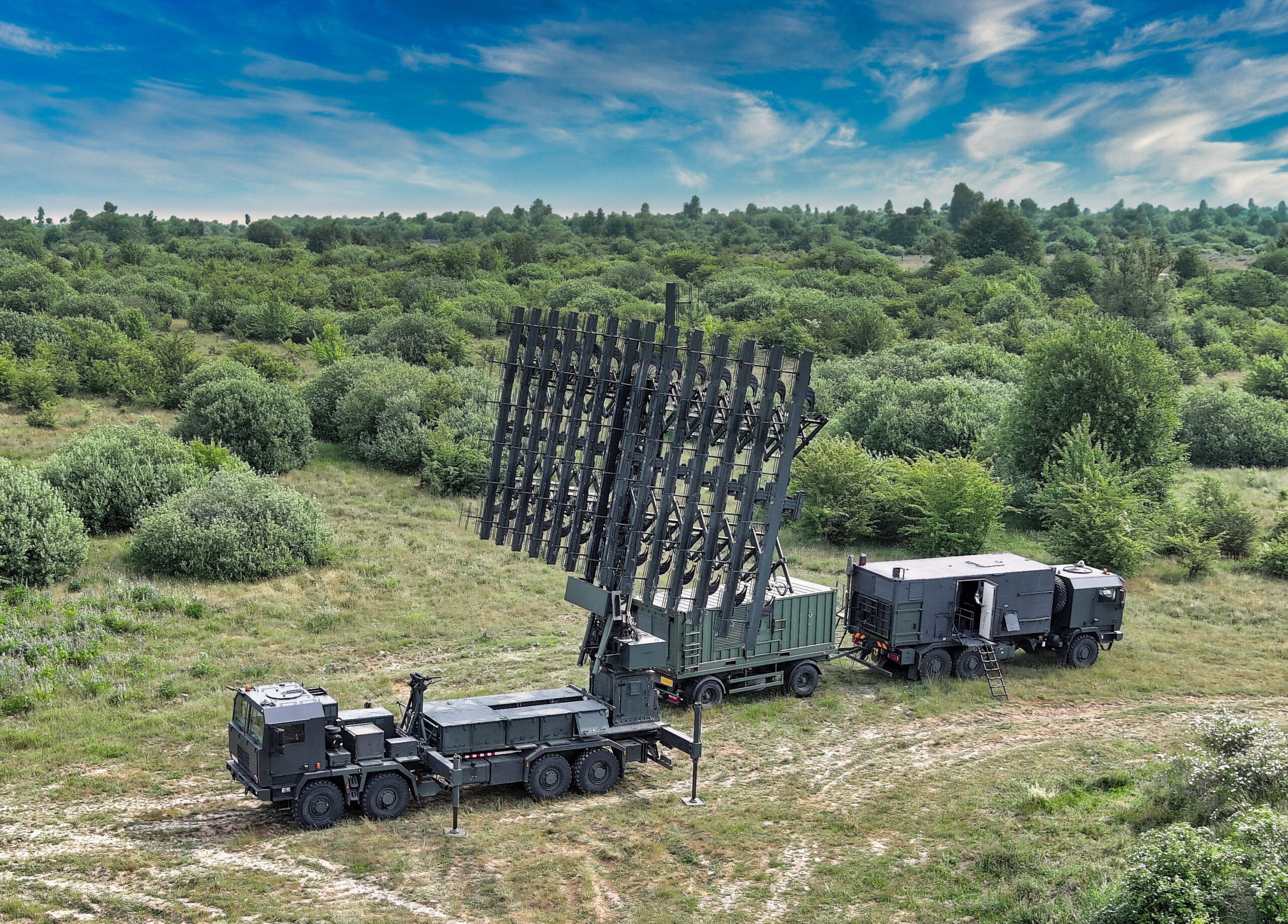 Photos: senior sergeant Piotr Gubernat, Combat Camera, journalist team of Armed Forces Operational Command
Photos: senior sergeant Piotr Gubernat, Combat Camera, journalist team of Armed Forces Operational Command
Why meter wavelength?
In the broadly understood West, use of meter-band radars has been abandoned a long time ago. Since the dawn of radar technology, its evolution has been driven towards increasing the radar signal frequency, because of, among other reasons, a simple relationship – the larger the ratio of the antenna size to the wavelength, the sharper the beam characteristics. As a result, the precision in determining location and recognition of targets improves. In order for these parameters to be comparable to devices operating at even higher frequencies, it was necessary to build proportionally larger VHF antennas. For example, the transmitter antenna of the first fully operational radar (since 1938) – the British RDF – was a large installation placed on 4 steel towers 110 m high, standing at intervals of 55 m from each other. The structure of the receiving antenna was slightly smaller, using 4 wooden towers 73 m high. Initially, the radar operated on a 12-meter wave (25 MHz, although later the available range was extended to 20-55 MHz, corresponding to 5.45-15 m wavelengths), which wasn’t a deliberate choice, being enforced by limitations of contemporary electronics. Among the available electron tubes, only triodes had adequate power at that time, allowing them to generate waves with a frequency of several dozen MHz. Progress in electrical engineering allowed for a rapid increase in these values, and the German Freya radar, also developed before the war, operated at a wavelength of 1.2 m (250 MHz), and triodes reaching frequencies up to 700 MHz were already being put into production. The appearance of new types of electron tubes – first the klystron, and then the cavity magnetron, allowed for the reduction of the wavelength in radiolocation to the decimeter and then the centimeter range (frequencies of the order of 1-10 GHz). Since then, it seemed that the direction of radar development had been determined – radars using meter waves would be a thing of the past, and they would be replaced by more precise radars operating in the decimeter and centimeter microwave bands.
Generally, that is what has happened in Western countries. The few exceptions to this rule were large stationary long-range radars constructed by General Electric, such as the specialized AN/FPS-17 ballistic missile detection radar operating at a wavelength of 1.4-1.7 m (175-215 MHz) or intended for early detection of aircraft AN/FPS-24, with 12 units produced in years 1958-62, operating at a wavelength of 1.27-1.4 m (214-236 MHz). However, this was the end of the use of this band in American radars, and subsequent devices that replaced them switched completely to the decimeter waves.
The situation was completely different in the East. After World War II, the radio industry in the USSR was less developed than in Western countries and the implementation of mass production of radars operating at shorter wavelengths was not immediately possible. Therefore, a decision was made to further develop radars using meter waves, which was to be handled by the Plant No. 197 “Lenin” in Gorky (currently Nitiel – Nizhegorodsky Tielewizionnyj Zavod “V. I. Lenin” in Nizhny Novgorod) together with the Special Design Bureau established therein (currently NNIIRT – Nizhegorodsky Teachno-Issledowatielskij Institut Radiotiechniki). Their first task was to develop a modernization of the P-3 radar operating at a wavelength of approximately 4 meters (72 MHz). Despite their lower precision, meter-range radars had at least two advantages at the time. First, they were simpler, more reliable and much cheaper to produce. The latter was particularly important in the case of such a large country as the USSR. Providing a continuous radar field along the borders and, even over only part of the country’s territory, required the production of thousands of radar stations, which was a significant cost. Secondly, waves in the meter band are less attenuated in the atmosphere than decimeter and centimeter waves, hence they are well suited for use in long-range radars whose task is to detect, rather than precisely track, a target. At that time, when strategic bombers carrying nuclear bombs were considered the primary threat, their early detection was crucial to defending against a possible attack. As a result, after the P-3A radar was put into production in 1948, subsequent designs were developed as its successors: P-8 produced in 1951-55, P-10 (1954-60), and then P-12 (1957 -78) and finally P-18 (1971-91). Radars of these types are used by virtually all branches of the Soviet military – land forces, air defense, and air forces. Such wide use resulted in a very large scale of production. The record-setter in this respect was the P-12, produced in many variants for over 20 years, with 6,396 units manufactured (of which 1,188 were exported). P-18 takes the second place with over 4,000 units produced. It also became the most exported Soviet radar – as many as 1,218 sets were shipped outside the USSR.
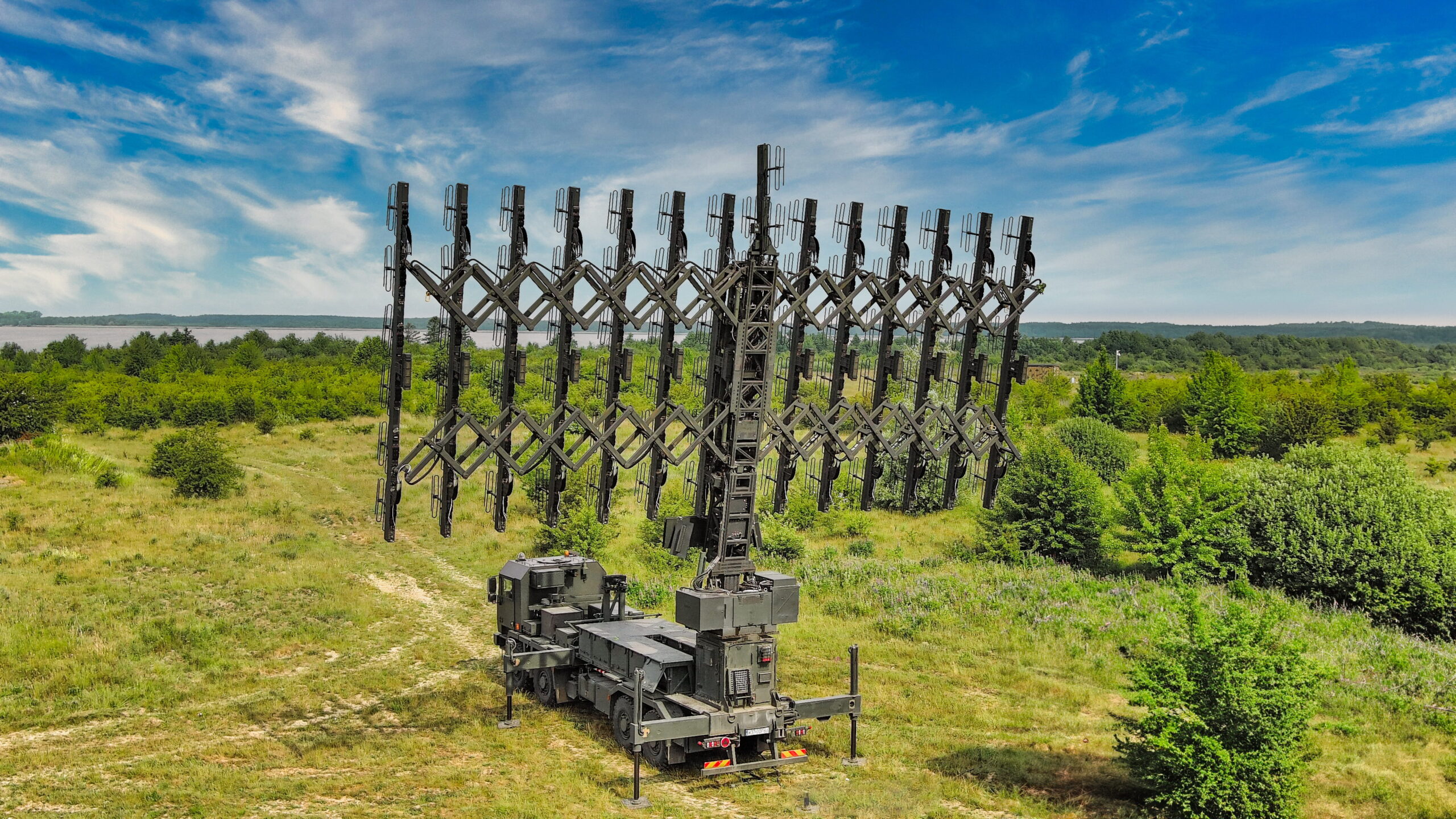 Thanks to the use of a hydraulically foldable antenna, the P-18PL can be unfolded and collapsed in less than 30 minutes
Thanks to the use of a hydraulically foldable antenna, the P-18PL can be unfolded and collapsed in less than 30 minutes
Predecessor Of The P-18PL
Developed at the turn of the 1960s and 1970s, operating in the meter band (1.75-2 m; 150-170 MHz), the P-18 was widely exported. The first radar stations of this type, known under the codename Laura, arrived in Poland in 1976. Deliveries of further units continued until the end of the 1980s, making it the most common type of radar imported by the Polish Army. At the beginning of 1990, they were in the hands of the radio-technical units of the Polish Army, and their primary user, the Polish Air Defense Forces. In the latter, they served in both the radio-technical units, and the missile and artillery units. And it was the missile units who were their foremost users – 42 sets of P-18 radars provided radar coverage for 21 battalions armed with S-125M Neva SAM batteries, and, together with PRW-13 radio altimeters, for 21 battalions equipped with S-75M Volkhov.
While the Soviet-made equipment was gradually withdrawn from the radio-technical units in the following years and successively replaced with Polish-made radars, the P-18 sets remained the primary method of detection for the missile battalions, rearmed in the meantime with modernized S-125SC Neva-SC SAM batteries. This situation made the military think about a suitable successor to the increasingly obsolete Soviet devices. At this point it should be noted that radars operating in the meter band have an unexpected advantage that their designers probably did not intend. Radio waves of this length have different scattering characteristics than waves in the microwave band, which means that the currently used techniques of reducing radar detection (stealth technology) have lower effectiveness against them. Paradoxically, it turned out that the methods of reducing the detectability of aircraft by radar means developed since the mid-1970s, do not protect them from detection using radars operating in ranges abandoned in the West due to their inferior parameters.
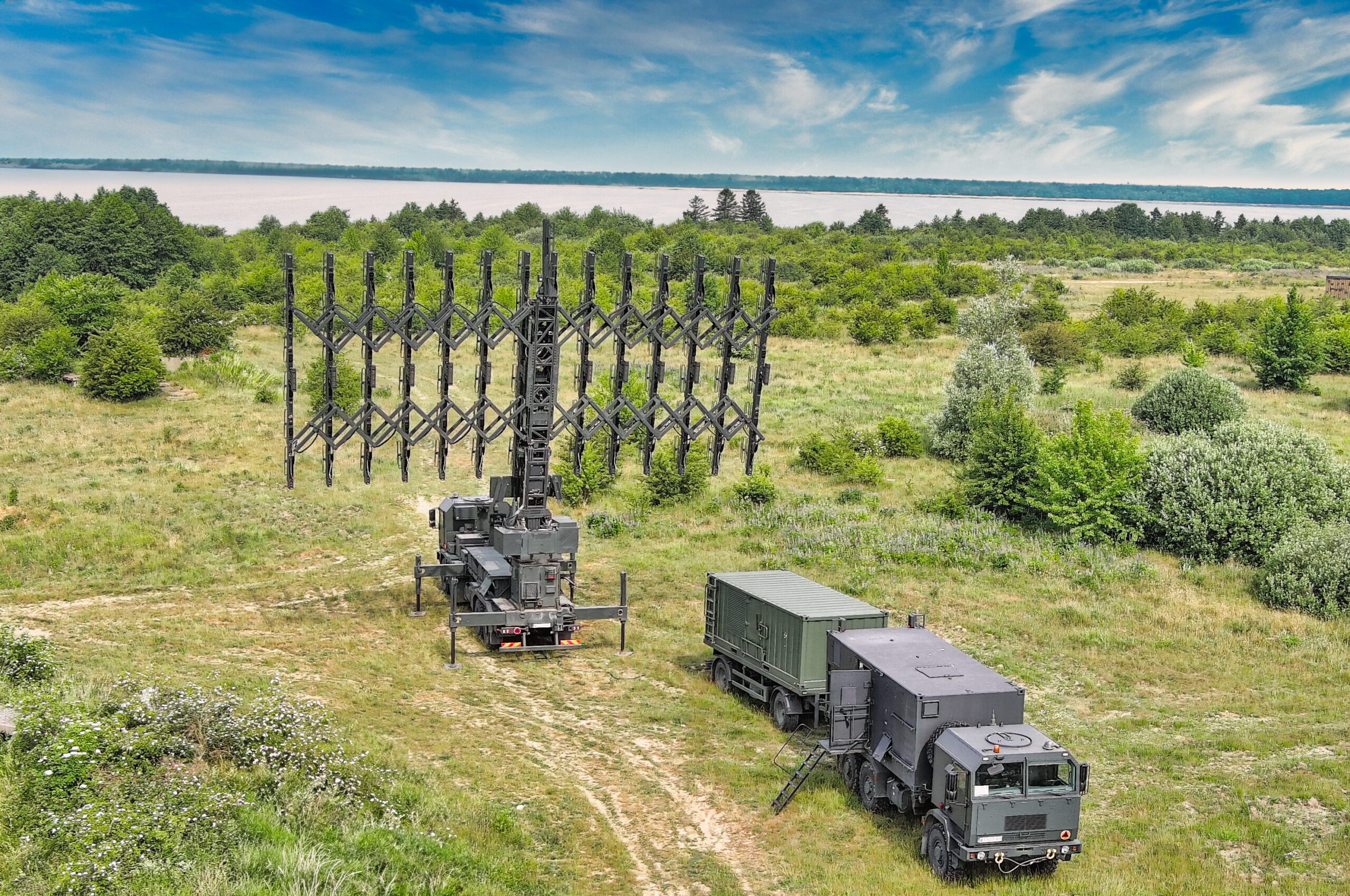 P-18PL radar station set up in the field. In real combat operations, it is possible to move the operators’ vehicle several hundred meters away from the antenna vehicle, increasing staff safety in the event of an attack on the radar
P-18PL radar station set up in the field. In real combat operations, it is possible to move the operators’ vehicle several hundred meters away from the antenna vehicle, increasing staff safety in the event of an attack on the radar
Development of a new radar
The above-mentioned reasons caused the Polish Air Forces to show interest in acquiring a successor to the P-18 radar, operating in the same band, but adapted to the requirements of the modern battlefield and harnessing all the capabilities of modern radar technology and electronics. Like the original, the new design was to be a mobile early warning radar, but equipped with an active electronically scanned array (AESA). It can be said that, to some extent, expectations were directed towards the development of a Polish equivalent of the Russian 1L119 Nebo-SVU radar station, which was adopted for service in 2003 and constitutes the next link in the development of meter radars by the mentioned earlier NNIIRT.
These initial expectations became the basis for creating a consortium consisting of PIT-Radwar S.A. (then called Bumar Elektronika S.A.) and the Military University of Technology, in order to develop a prototype of a meter-band radar for early target detection for air defense missile systems, with a beam electronically steered in two planes, with the working designation P-18PL.
In order to provide funds for the development of a new radar, on May 9, 2012, the Minister of National Defense entered it in competition No. 3/2012 of the National Center for Research and Development for the implementation of projects in the field of scientific research or development work for the defense and security of the state. The contract no. DOBR/0042/R/ID1/2012/13 concluded with the National Center for Research and Development on December 19, 2012 originally provided for the completion date of the works on December 18, 2016. However, the lack of clear preliminary tactical and technical specifications (WZTT) at the time of launching the project resulted in the Ministry of National Defense approving neither the tactical and technical specifications (ZTT) developed by the contractor nor the program of preliminary research and qualification tests. Therefore, in order to adjust the contract to formal and legal requirements, it was subject to a critical review that took place between November 21, 2014 and June 1, 2016, during which, as explained in April 2017 by the Secretary of State at the Ministry of National Defence, Bartosz Kownacki, representatives of the Ministry of Defense National team formulated recommendations aimed at adapting the P-18PL to the needs of the Polish Armed Forces.
This did not significantly affect the work on the prototype itself, which was completed in 2017, although its individual components were being created since 2015. Further development led to the P-18PL reaching its final form in 2019. This allowed initiation of the in-house tests aimed at confirming, in accordance with the prepared program, the essential characteristics of the radar included in the tactical and technical specifications, and assessing the possibility of presenting the prototype for qualification tests. The positive completion of in-house tests in 2020 led to the final phase of the project, the qualification tests conducted by a commission appointed by the head of the Armament Inspectorate (currently the Armament Agency). At that stage, all requirements contained in the ZTT need to be formally confirmed, the accuracy of the presented technical documentation of the prototype needs to be fact-checked, and the applicability of the solutions used in the prototype on the launch of serial production is assessed. Ultimately, the qualification tests were finished with positive results in December 2022, as announced by the spokesman of the Armament Agency on December 23, 2022.
On 19 December 2023, the Armament Agency and the PGZ-Narew Consortium signed an executive agreement for the delivery and service of 24 P-18PL (UW-10) long-range radar sets. The contract will be implemented in the years 2023-2035 and its value is over PLN 3.1 billion. Deliveries are expected to start no later than 2027.
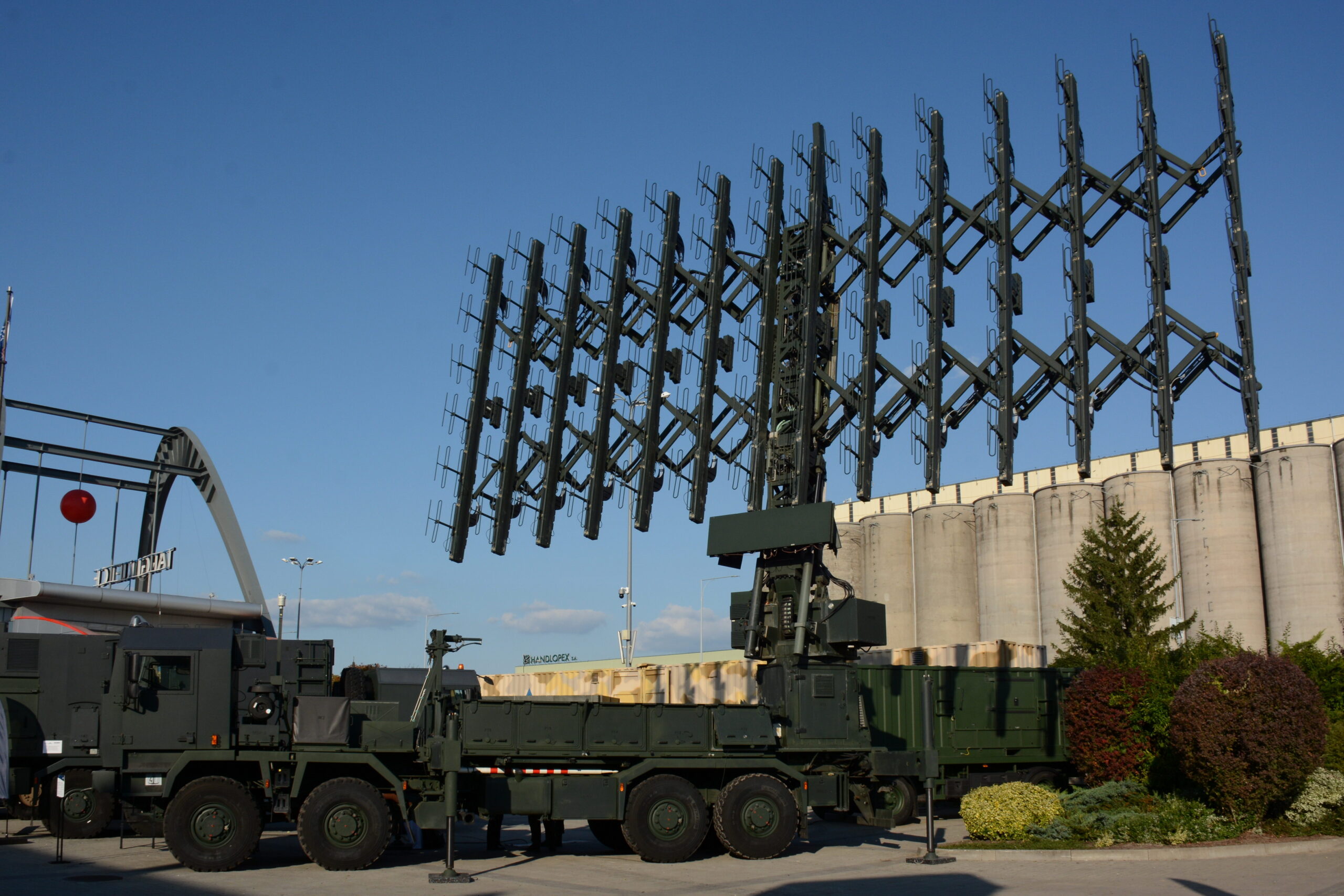 WA-18 radar vehicle designed on the Jelcz P882 chassis with antenna system, object detection and tracking system processor, control system, and power supply / Photos: MILMAG Archive
WA-18 radar vehicle designed on the Jelcz P882 chassis with antenna system, object detection and tracking system processor, control system, and power supply / Photos: MILMAG Archive
P-18PL capabilities
P-18PL is a mobile, three-coordinate (3D) long-range radar operating in the meter band (VHF), designed to detect and track both classic aircraft, including stealth objects, as well as tactical ballistic missiles. Thanks to use of a hydraulically foldable antenna, the time needed to deploy the station in operational mode is very short – the preliminary specifications requested a maximum of 30 minutes, but in practice, much shorter times were achieved during the tests. The P-18PL was created as an early detection radar for air defense missile systems, but the result was a device with parameters allowing for much wider use than originally assumed.
According to the manufacturer, the radar can perform the following functions:
- long-range preliminary detection of aerial objects and defense against ballistic and hypersonic missiles,
- target detection and designation for medium- and short-range air defense systems,
- short, medium, and long range airspace control,
- supporting own air forces
Fulfilling so many different tasks is made possible by setting up multiple modes of work, allowing for flexible adjustment of operational parameters to fit the mission being performed, including range, detection ceiling, and radar information update time. Since the phase of preliminary assumptions the new radar was expected to become a means of detecting targets for Wisła medium-range air defense missile systems, which are capable of shooting down ballistic missiles, one of the initial requests was accommodation for detection of that type of targets. The ordering party also decided that for this purpose the radar should have a maximum range of 900 km, and not 600 km as originally proposed by the designers. In the very long-range operation mode, targets are detected at a maximum distance of 900 km at an altitude of up to 160 km. In long-range mode, these values are reduced to 600 and 120 km, respectively. For initial detection, a wide sweep is made with a 360º antenna rotation, covering an elevated arc of 25º in the search mode and 45º in the tracking mode. The radar can also operate in sector mode, when, with the antenna stationary, a scan of 90º arc of azimuth is performed electronically. This operating mode is intended mainly for detecting targets while defending against tactical ballistic missiles, when it is important to be able to quickly direct the beam to a selected region of sky in order to effectively track such fast objects. To shorten the search time through an entire sector, the radar’s instrumented range is reduced.
Different detection channels are used depending on the target type. The radar automatically selects one of the available signal processing methods to match the characteristics of the detected target. In this way, depending on whether it is a classic aerodynamic target, a ballistic missile or another type of object, detection and tracking is performed along the path that gives the best results.
While working on the radar, the issue of detecting hovering helicopters also arose. When the moving target selection is used in the basic detection mode, hovering helicopters are eliminated as fixed echoes after a few signals. This resulted in the need to develop an additional detection channel adapted for that purpose.
During the tests, the radar showed great capacity for detecting targets with a small radar cross section. Even artillery shells with RCS of 0.001 or even 0.0001 m² were detected, which shows its ability to detect increasingly dangerous targets such as small unmanned aerial vehicles.
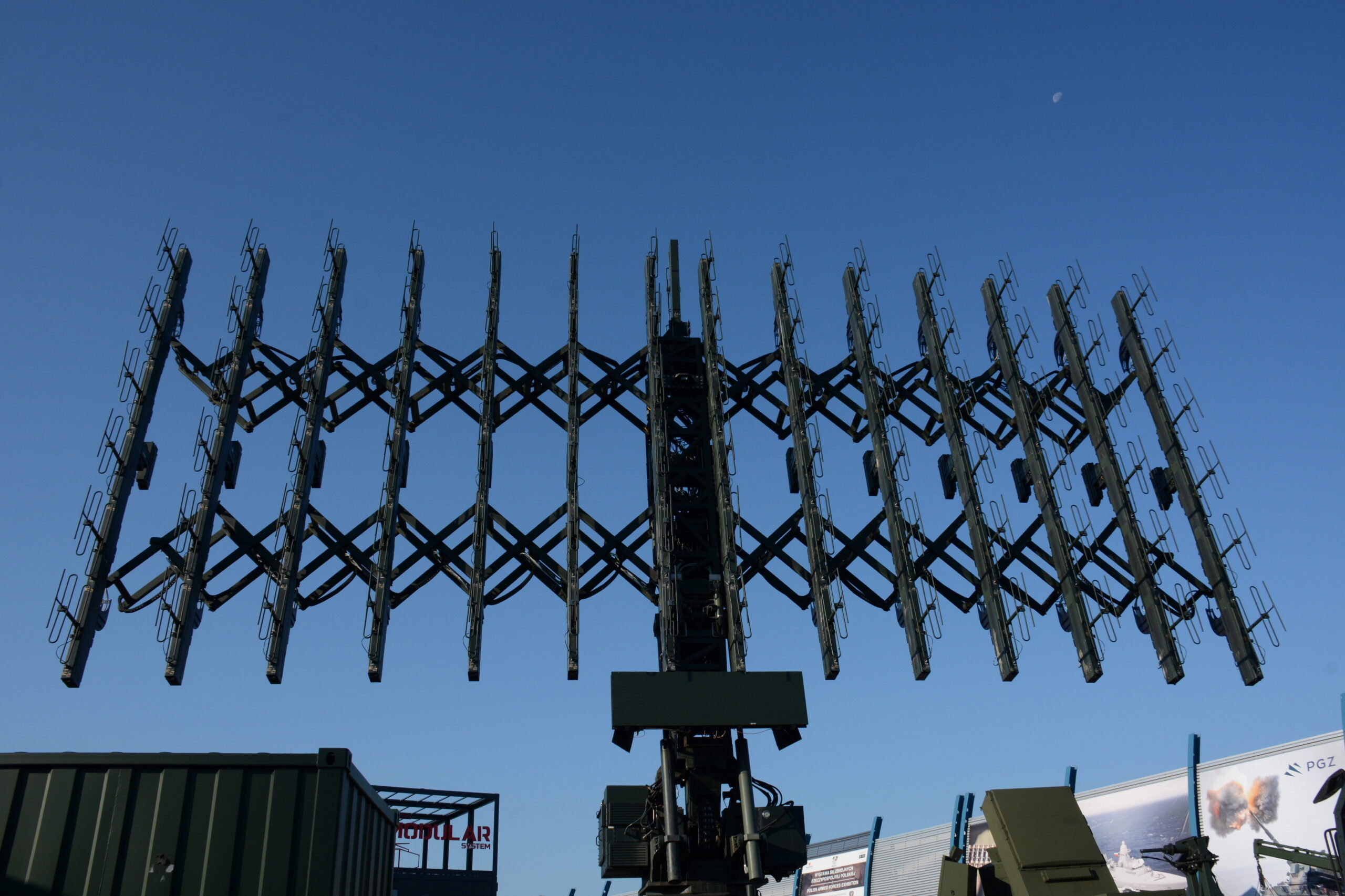 Frontal view of P-18PL, with 84 antenna elements visible, and IDZ-50 long-range interrogator antenna beneath
Frontal view of P-18PL, with 84 antenna elements visible, and IDZ-50 long-range interrogator antenna beneath
Component parts
P-18PL radar is composed of three main elements:
- WA-18 antenna vehicle, built on Jelcz P882 chassis. It includes the antenna system, object detection and tracking processor system, control system, and power system.
- WW-18 operators’ vehicle, mounted on Jelcz P662 chassis, containing operating stations, radar displays, and communication systems.
- JZ-18 power supply unit, a four-wheel trailer containing primary and reserve generators used to provide electricity for the antenna vehicle or a whole radar set
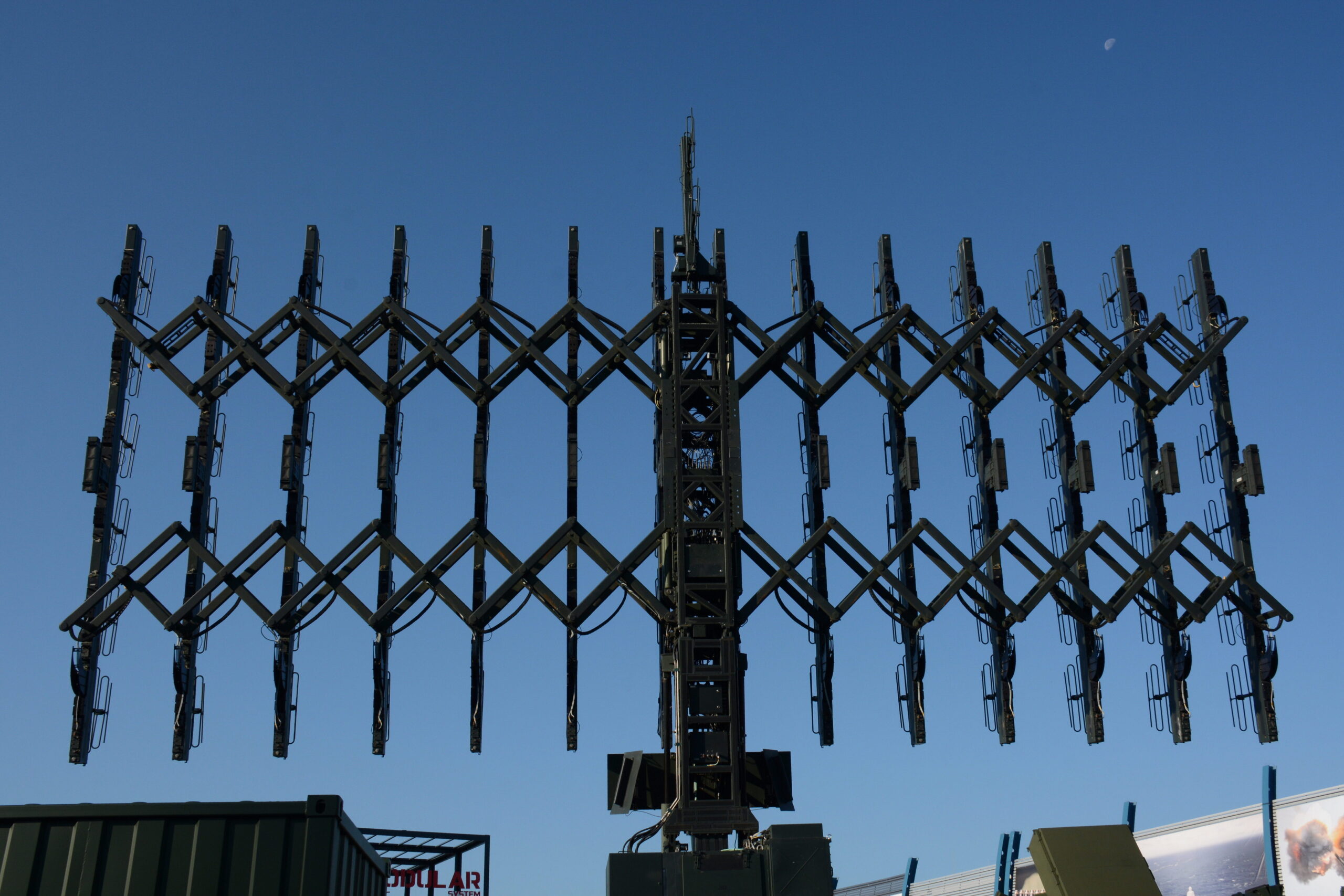 P-18PL antenna viewed from beings, with clearly visible scissor mechanism that supports the antenna permitting folding it quickly
P-18PL antenna viewed from beings, with clearly visible scissor mechanism that supports the antenna permitting folding it quickly
WA-18 antenna vehicle
The key element of WA-18 is an antenna built as an active electronically scanned array (AESA) composed of 84 transmitting and receiving modules with short Yagi-Uda antennas arranged in 14 columns and 6 rows. This is an identical configuration to the previously mentioned Russian 1Ł119 radar, although to some extent it is a coincidence. Fourteen columns turned out to be the maximum number that could be used so that the antenna, when folded, was no more than 4.0 m high and 2.5 m wide and could still fit on the Jelcz P882 chassis used by the vehicle. When unfolded, the antenna measures 14 x 6 m, emitting a beam 6º wide in azimuth and 12º in elevation. Thanks to the use of advanced signal processing, it allows to achieve target coordinate measurement precision with a accuracy of 30 m in distance and 0.3º in azimuth, which is an accuracy close to or comparable to radars operating in the microwave bands.
The radar is equipped with an identification friend-or-foe system (IFF) with the IDZ-50 long-range interrogator operating in the Mark XIIA Mod 5 and Mod S standards.
The antenna vehicle also has a computer system responsible for processing the signal to detect aerial objects, determine their location, track and classify them. It also includes a navigation system enabling precise orientation of the radar in relation to geographic north and a geodetic network link, as well as power systems, diagnostic systems, an antenna drive and a hydraulic system for expanding and retracting the radar.
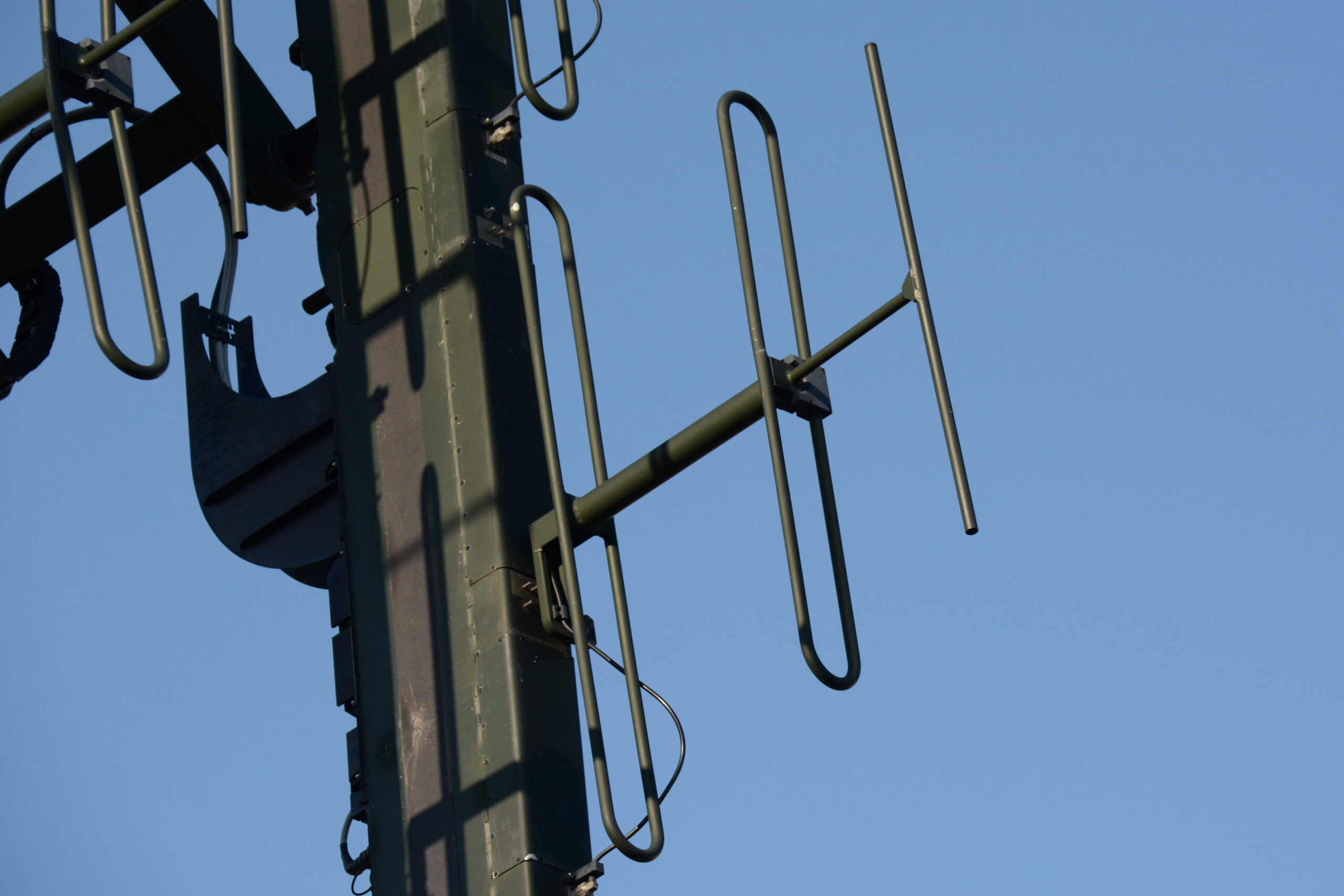 A close-up of the Yagi-Uda antenna, 84 pieces of which make up the complete P-18PL antenna
A close-up of the Yagi-Uda antenna, 84 pieces of which make up the complete P-18PL antenna
WW-18 operators’ vehicle
Information about detected and tracked objects, their classification and identification, is sent to the second vehicle, where operator stations are located in an armored container. This container provides the personnel with protection against small arms fire and shrapnel, as well as against weapons of mass destruction. Two operators from inside the container supervise the tasks performed by the radar, control its operating parameters, and check the correct functioning of the devices. One of the operator stations can be moved outside the container, such as when joining the command post of a radio-technical subunit or to the command cabin of an anti-aircraft set. The connection is provided through a single fiber optic cable up to 1 km long.
Additionally, information about the presence of jamming signals is relayed, allowing operators to determine the strength of the interfering signal, the frequency band and the direction from which the signal comes.
The operators’ vehicle also holds communication systems enabling the transmission of information to the group’s command systems and the reception of orders and notifications. The radar is prepared to exchange information with computer systems used in air defense units and air operations command centers. It can be done by radio or through cable lines. The open software architecture allows the radar to be adapted in the future to new communication protocols emerging with the advancement of command systems.
Because the operators’ vehicle can be moved away from the antenna vehicle and the power supply unit by several hundred meters, it is equipped with its own generator, which allows it to operate independently of the power supply unit.
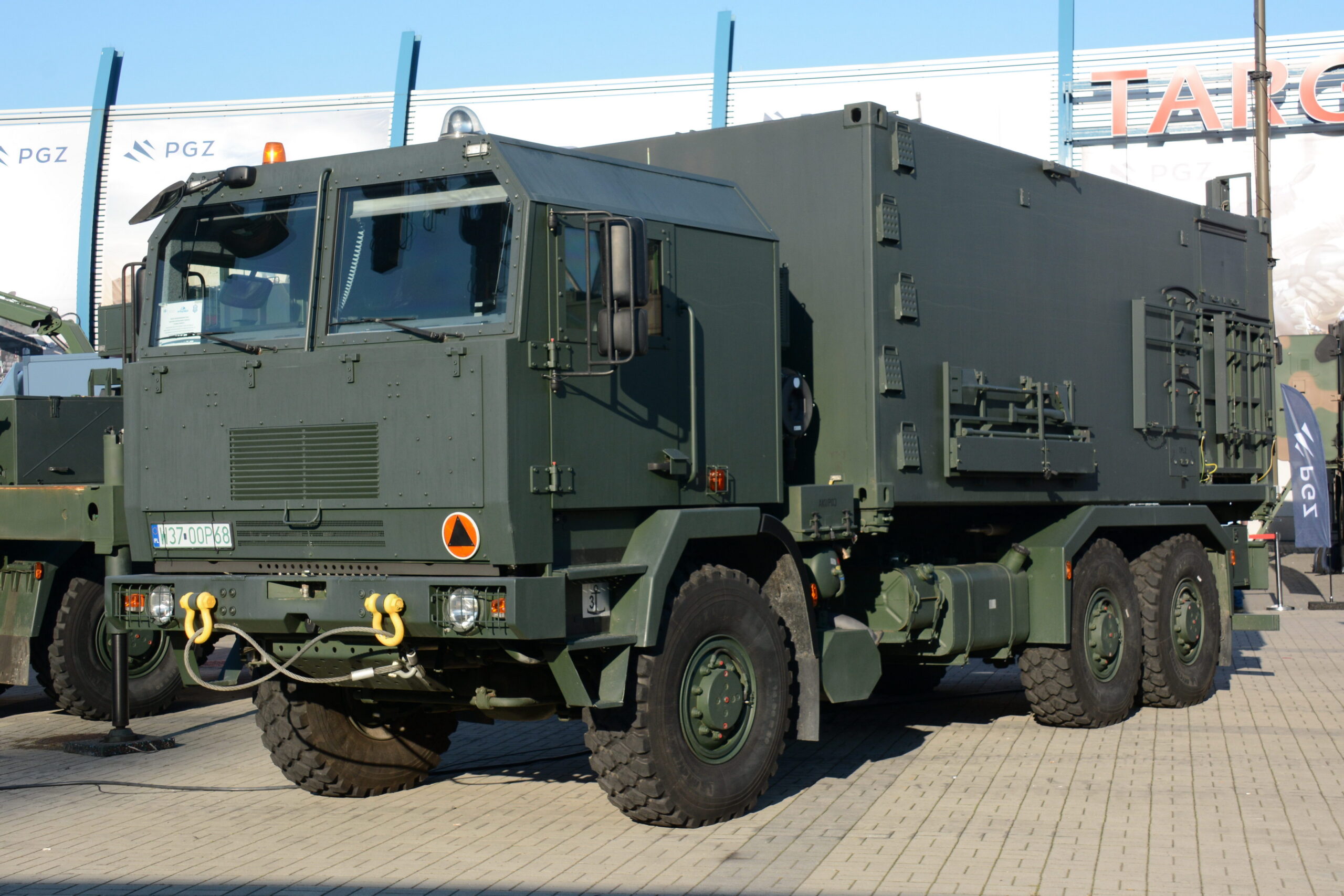 WW-18 operators’ vehicle, keeping the radar operators protected from small arms fire, shrapnels, and weapons of mass destruction within the armored container
WW-18 operators’ vehicle, keeping the radar operators protected from small arms fire, shrapnels, and weapons of mass destruction within the armored container
JZ-18 power supply unit
It provides power to the radar using two generator sets. One of them is enough to power the entire set, the second one serves as a backup in case the first one fails. P-18PL can also be powered from external sources that meet the requirements of a typical industrial electrical network power connection.
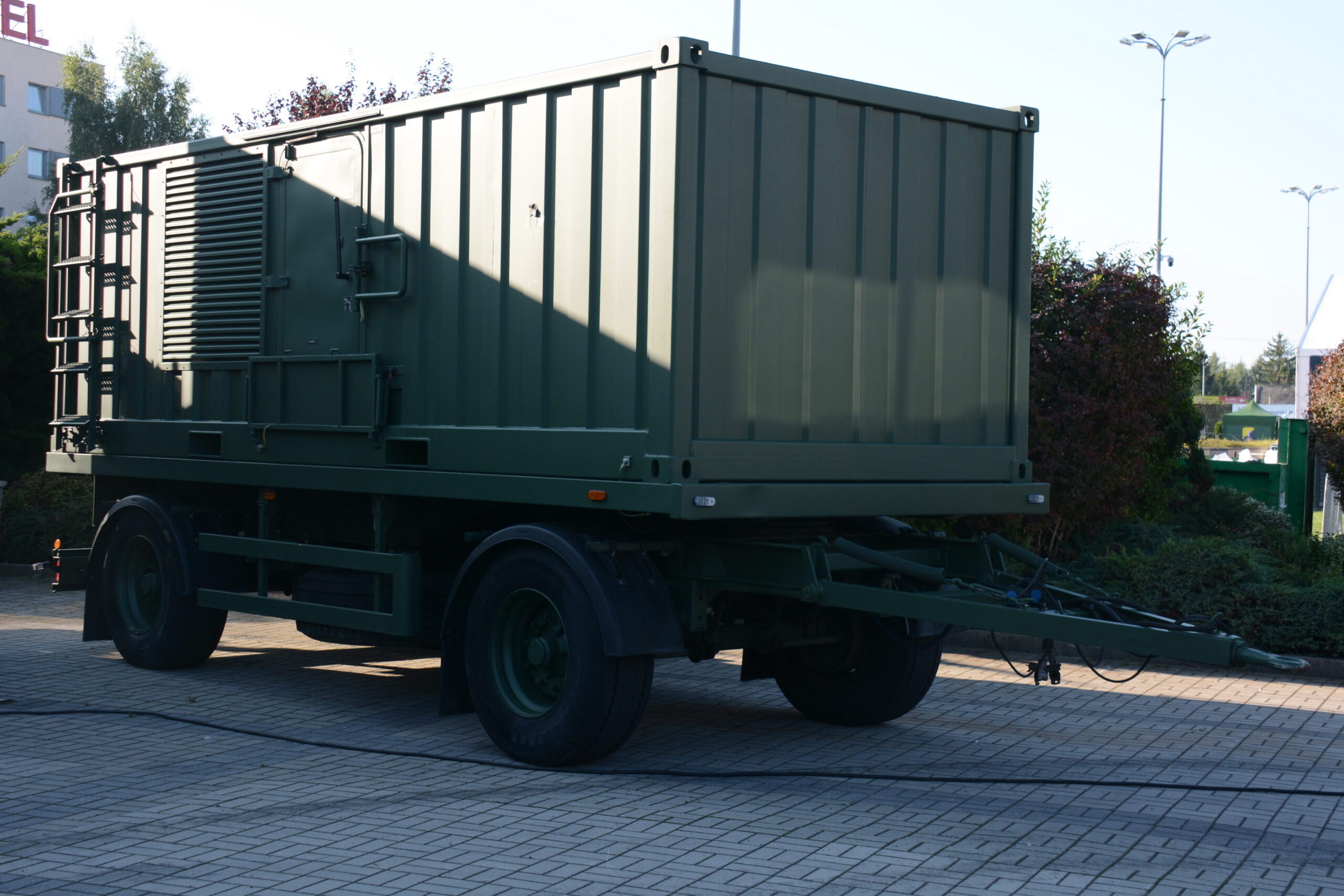 JZ-18 power supply unit is equipped with two electric generators. One is enough to power the radar, the other functions as a backup
JZ-18 power supply unit is equipped with two electric generators. One is enough to power the radar, the other functions as a backup
Summary
The development of the P-18PL can be considered a significant achievement for the team working on it. Although PIT-Radwar has extensive experience in the construction of radars, the development of a device using a bandwidth that has never been used by radars designed natively in Poland before required a lot of research and taking into account the specific qualities of the meter band when it comes to signal processing algorithms. Electronic beam steering, or more broadly, designing the radar with focus on maintaining its physical structure as much as possible and making changes by modifying the software, allows for further improvement of its parameters. This can be done, for example, by using the possibility of freely shaping the emitted beam, as well as with the aid of new methods of information processing – signal processing algorithms, introducing additional operating modes, or information integration.
Obviously, that work on introducing further improvements and expanding the system’s capabilities continues, although it is still too early to provide further details. Currently, the crucial issue is to start the production of this radar, which will be a key step on the path to its further development. The introduction of the P-18PL into the armament of the Polish Army should also have a positive impact on the export opportunities of this new design.
As mentioned earlier, currently no one in the broadly understood West produces radars operating in the meter band. Devices of this class are currently manufactured only in China (JY-27), Belarus (Vostok-D), and in Russia, where the entire family of radars in this category is produced: RLM-M of the 55Zh6M Nebo-M complex, 55Zh6UT Nebo-T, 55Zh6UM Niobium, 1L125 Niobium-SW or 103Zh6. For obvious political reasons, none of these countries will be a supplier of weapons to NATO countries and their allies in the foreseeable future. Taking into account the widespread use of P-18 radars in the world, it can be expected that their successors will be sought beyond Poland. In this context, it should be noted that old P-18s are still in service with the armed forces of Romania, which, it should also be added, was an importer of Polish NUR-31/31M and NUR-41 radars in the past. And while it would be desirable that the new Polish mass produced radar would receive a completely Polish designation, not referring to the old Soviet design, with which it is connected only by the wavelength used, from the point of view of potential export, the P-18PL designation may turn out to be quite a favorable solution.




Comments
Nobody has commented on this article yet.